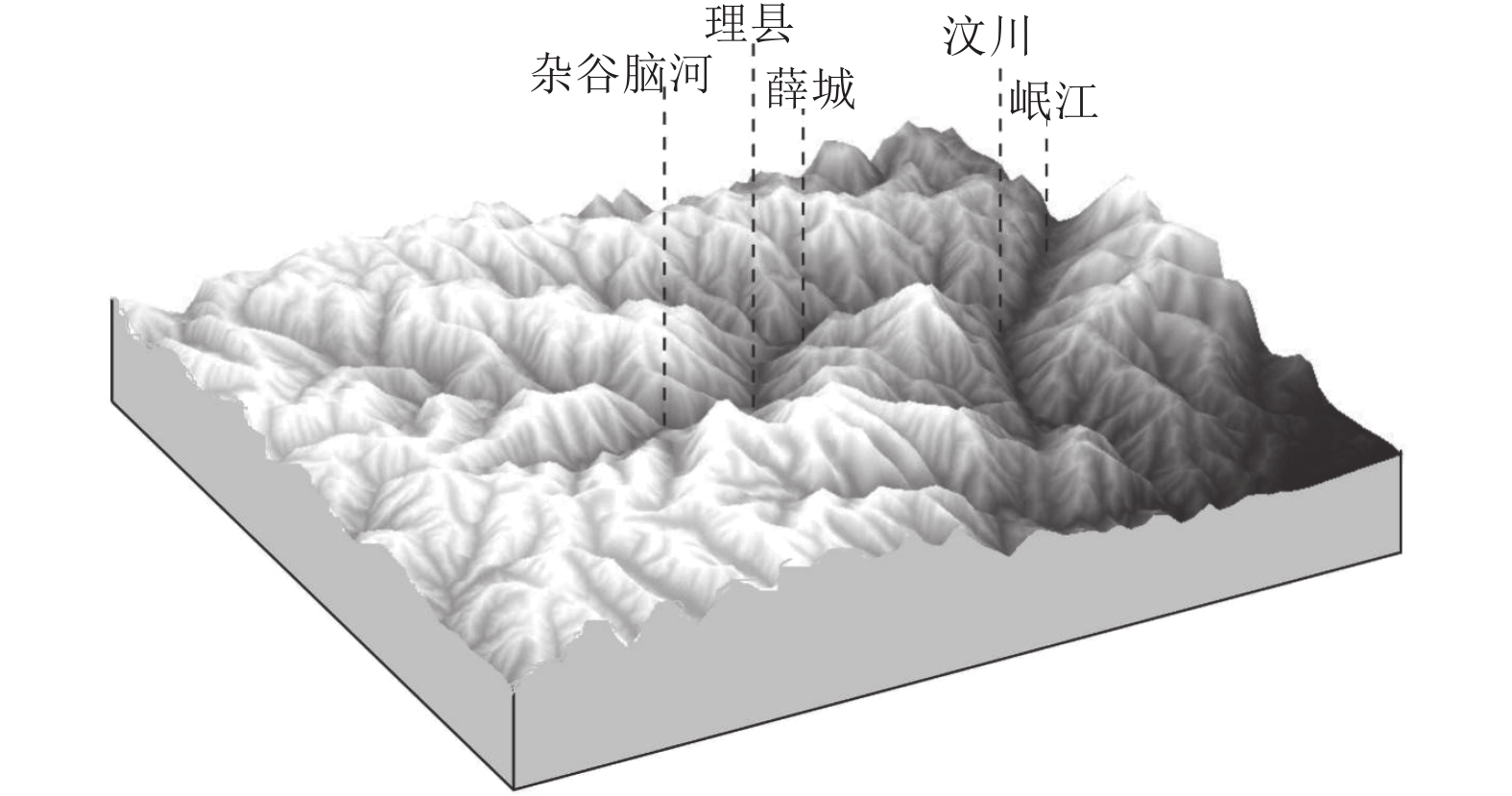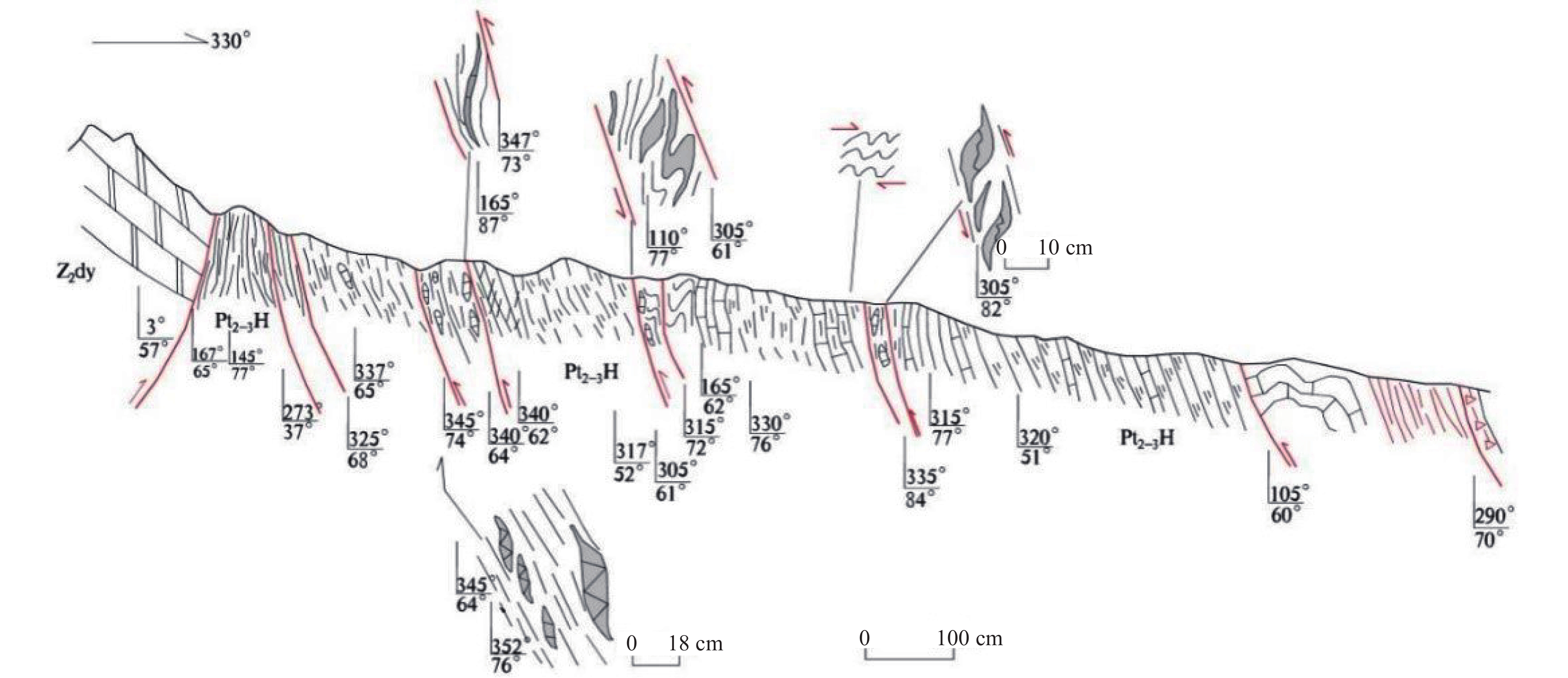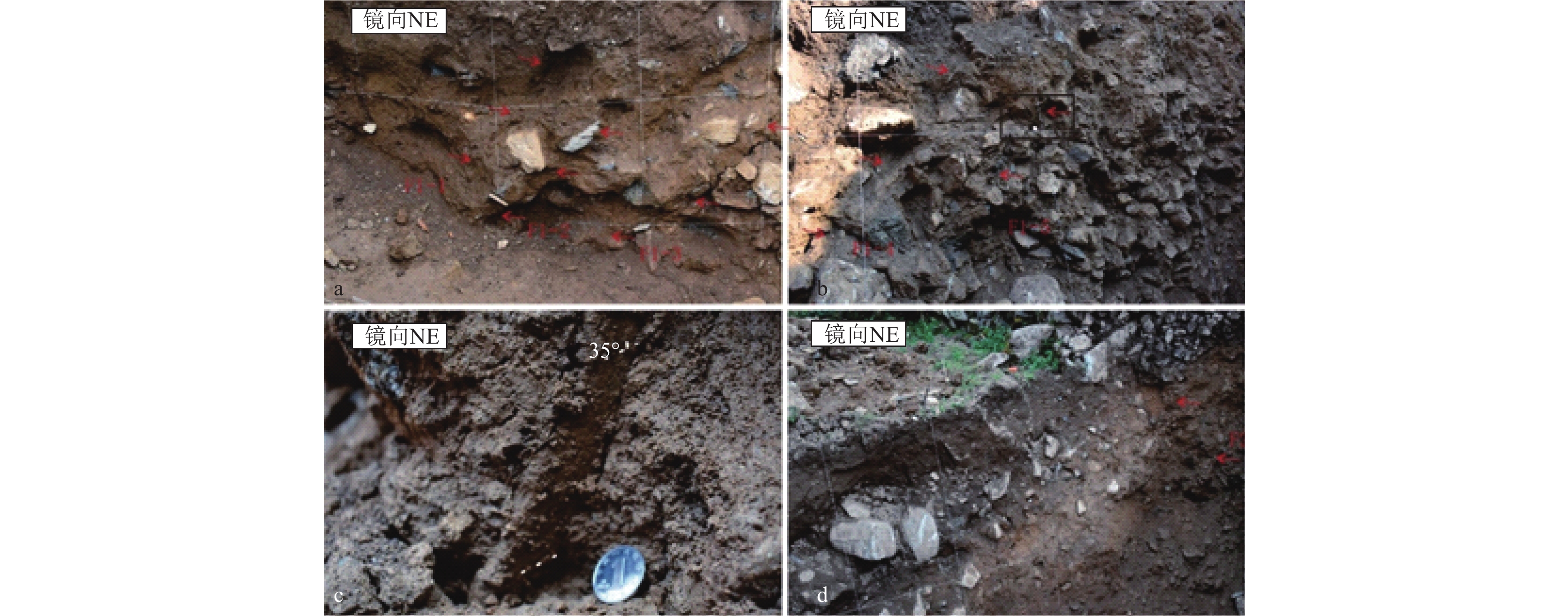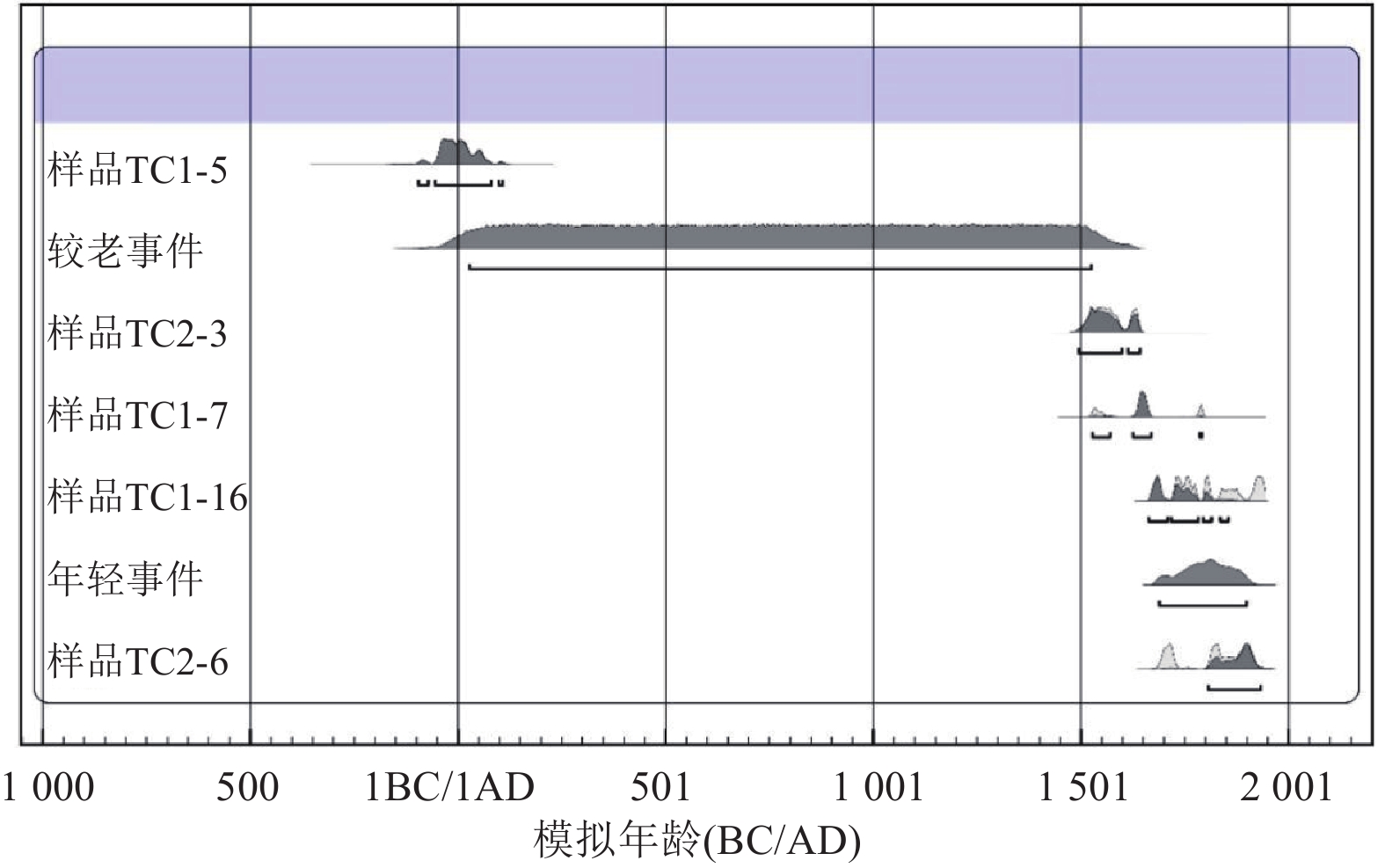Evidence of the Holocene Seismic Activity of the Wenchuan Segment of the Maoxian-Wenchuan Fault
-
摘要: 茂县-汶川断裂是龙门山推覆构造带的重要组成部分,又称龙门山后山断裂,是龙门山构造带形成的重要断裂,对解释青藏高原动力学和南北地震带的变形特征具有重要意义。已有学者对茂县-汶川断裂活动性采取不同手段展开调查研究,使用ESR、TL等多种方法表明断裂在晚更新世有过活动,但断裂在晚第四纪特别是全新世有无活动缺乏可靠的直接证据。为此,在汶川县草坡一带,综合地震地貌、探槽和年代分析等手段,揭露了2次古地震事件,分别距今约(345±20)a、(2015±30)a,证明了茂县-汶川断裂汶川段在全新世以来有过活动。Abstract: The Maoxian-Wenchuan Fault, also called Longmenshan Back—Mountain Fault, is an important component of the Longmenshan Nappe structure belt, which is the important fault of the Longmenshan tectonic belt. It has great significance to the interpretation of the transformation characteristics of the Qinghai—Tibet plateau dynamics and its seismic belts in the south and north. Scientists from China and abroad have carried out survey and research works on activity of the Maoxian—Wenchuan Fault using various means and methods, such as ESR and TL. The results indicate that the fault had been active during the Late Pleistocene. However, the activity of the fault during the Late Quaternary, especially the Holocene, is in lack of reliable and direct evidence. In the Caopo region of Wenchuan County, two paleo—seismic events are identified by methods of seismic geomorphology, exploratory trench and chronologic analysis, which are aged (345±20) a, (2015±30) a, respectively. The events prove that there had been seismic activities in Wenchuan segment of the Maoxian—Wenchuan Fault since the Holocene. Further works need to do on whether the 345±20 a seismic event was related to the 6½ magnitude earthquake in 1657 in Wenchuan County in Wenchuan County, and on the paleo—seismic implication the colluvial wedge represents in the trench Tc1.
-
Key words:
- Paleoearthquake events /
- Holocene /
- Maoxian-Wenchuan fault /
- Wenchuan county /
- Caopo township
1)1 2 四川省地质调查院,2010. 绵阳市1∶25万区域地质调查.2)2 3 四川省地质局区域地质测量队,1975. 1∶20万茂汶幅、灌县幅区域地质调查报告(地质部分).3)3 4 四川省地质矿产勘查开发局川西北地质队,2013. 1∶25万绵阳市幅区域地质调查报告. -
表 1 探槽揭露地层与样品年代
Table 1. Form of trenching exposes strata and sample age
层号 地层描述 样品描述 Tc1—U1 灰色含黏土砾石层,砾石呈棱角状或次棱角状,分选差,砾径2~40 cm。岩石成分以玄武岩、安山岩等为主,物源来源于探槽东侧山区元古界黄水河群,因此,该层应是古河谷的沉积物。 Tc1—U2 灰白色,层中顺坡堆积大小不一、碎块状灰绿色千枚岩,应为西侧志留系千枚岩崩塌,在坡脚处受流水改造堆积而成。 Tc1—U3 浅灰黄色土层,局部夹风化的小砾石,该层厚度整体较稳定,在东侧受断层作用突然下掉加深。 炭屑样14C:(2 015±30 ) a Tc1—U4 灰黑色含砾黏土层。砾石砾径约1 cm,磨圆好;局部发育磨圆较差、砾径约5 cm砾石。该层呈上凹型,地层在剖面东侧较厚。 炭屑样14C:(260±25) a Tc1—U5 棕黄色含砾黏土层,整体呈上凹型。 炭屑样14C:(345±20) a Tc1—U6 灰黑色含砾黏土层,较薄,往两端尖灭。 Tc1—U7 浅棕黄色含砾黏土层,局部含砾径约2 cm的小砾石。厚度上具有向南侧变厚的趋势,终止于断层附近。 炭屑样14C:(155±20) a Tc1—U8 灰黑色地表耕植土,在剖面北侧较厚,向东减薄。 Tc1—U9 灰色~灰黑色砾石层,砾石松散,呈点、线接触,砾石间黏土少,充杂植物根系,疑似人工堆砌形成 Tc2—U1 浅棕红色含砾粉砂、黏土层,砾石粒径1~2 cm,磨圆较好。 Tc2—U2 灰黄色砾石层,砾石分选差,大的砾径可达50 cm左右,磨圆较好,砾石成分主要为玄武岩或安山岩。 Tc2—U3 灰色含砾石黏土层,局部夹有砾径较小的砾石,磨圆较好,具中间薄、两侧厚特征。 炭屑样14C:(315±20) a Tc2—U4 地表根植层,层中局部有现代植物腐木等。 炭屑样14C:(85±30) a -
邓起东, 陈社发, 赵小麟, 1994. 龙门山及其邻区的构造和地震活动及动力学. 地震地质, 16(4): 389—403Deng Q. D. , Chen S. F. , Zhao X. L. , 1994. Tectonics, scismisity and dynamics of Longmenshan mountains and its adjacent regions. Seismology and Geology, 16(4): 389—403. (in Chinese) 丁国瑜, 1982. 古地震标志问题. 见: 中国地震学会地震地质专业委员会主编, 中国活动断裂. 北京: 地震出版社, 276—286. 李海兵, 付小方, Van Der Woerd J. 等, 2008. 汶川地震(MS 8.0)地表破裂及其同震右旋斜向逆冲作用. 地质学报, 82(12): 1623—1643 doi: 10.3321/j.issn:0001-5717.2008.12.002Li H. B. , Fu X. F. , Van Der Woerd J. , et al. , 2008. Co-seisimic surface rupture and dextral-slip oblique thrusting of the MS 8.0 Wenchuan earthquake. Acta Geologica Sinica, 82(12): 1623—1643. (in Chinese) doi: 10.3321/j.issn:0001-5717.2008.12.002 李勇, 曾允孚, 伊海生, 1995. 龙门山前陆盆地沉积及构造演化. 成都: 成都科技大学出版社, 1—91. 李勇, 周荣军, Densmore A. L. 等, 2006. 青藏高原东缘龙门山晚新生代走滑—逆冲作用的地貌标志. 第四纪研究, 26(1): 40—51Li Y. , Zhou R. J. , Densmore A. L. , et al. , 2006. Geomorphic evidence for the late Cenozoic strike—slipping and thrusting in Longmen Mountain at the eastern margin of the Tibetan Plateau. Quaternary Sciences, 26(1): 40—51. (in Chinese) 廖炳勇, 何晓飞, 曾强等, 2019. 龙门山构造带茂县-汶川断裂在茂县、汶川一带构造特征. 四川地质学报, 39(3): 374—378 doi: 10.3969/j.issn.1006-0995.2019.03.005Liao B. Y. , He X. F. , Zeng Q. , et al. , 2019. Charecteristics of the Maowen fault in the Longmenshan structural belt. Acta Geologica Sichuan, 39(3): 374—378. (in Chinese) doi: 10.3969/j.issn.1006-0995.2019.03.005 林茂炳, 俞广, 1997. 茂汶韧性断裂带(耿达—汶川段)的基本特征. 成都理工学院学报, 24(2): 40—47Lin M. B. , Yu G. , 1997. Principal features of Maowen ductile fault zone (Wenchuan—Gengda section). Journal of Chengdu University of Technology, 24(2): 40—47. (in Chinese) 骆耀南, 俞如龙, 侯立玮等, 1998. 龙门山—锦屏山陆内造山带. 成都: 四川科学技术出版社.Luo Y. N., Yu R. L., Hou L. W., et al., 1998. Longmenshan –Jinpingshan intracontinental orogenic belt. Chengdu: Sichuan Science and Technology Press. (in Chinese) 马保起, 苏刚, 侯治华等, 2005. 利用岷江阶地的变形估算龙门山断裂带中段晚第四纪滑动速率. 地震地质, 27(2): 234—242Ma B. Q. , Su G. , Hou Z. H. , et al. , 2005. Late quaternary slip rate in the central part of the Longmenshan Fault zone from terrace deformation along the Minjiang River. Seismology and Geology, 27(2): 234—242. (in Chinese) 孙浩越, 2016. 青川断裂晚第四纪活动性及其对区域构造运动模式的约束. 国际地震动态, 46(6): 32—34. doi: 10.3969/j.issn.0253-4975.2016.06.006 唐荣昌, 文德华, 黄祖智等, 1991. 松潘—龙门山地区主要活动断裂带第四纪活动特征. 中国地震, 7(3): 64—71Tang R. C. , Wen D. H. , Huang Z. Z. , et al. , 1991. The quaternary activity characteristics of several major active faults in the Songpan—Longmenshan Region. Earthquake Research in China, 7(3): 64—71. (in Chinese) 唐荣昌, 韩渭宾, 1993. 四川活动断裂与地震. 北京: 地震出版社. 唐文清, 张清志, 刘宇平等, 2012. 汶川地震后龙门山断裂带活动特征. 沉积与特提斯地质, 32(4): 106—110 doi: 10.3969/j.issn.1009-3850.2012.04.016Tang W. Q. , Zhang Q. Z. , Liu Y. P. , et al. , 2012. Active faulting along the Longmenshan fault zone after the 8.0 magnitude Wenchuan earthquake in Sichuan. Sedimentary Geology and Tethyan Geology, 32(4): 106—110. (in Chinese) doi: 10.3969/j.issn.1009-3850.2012.04.016 王旭光, 李传友, 吕丽星等, 2017. 龙门山后山断裂中段汶川—茂县断裂的晚第四纪活动性分析. 地震地质, 39(3): 572—586Wang X. G. , Li C. Y. , Lü L. X. , et al. , 2017. Analysis of the late quaternary activity along the Wenchuan—Maoxian Fault—middle of the back—range fault at the Longmenshan fault zone. Seismology and Geology, 39(3): 572—586. (in Chinese) 杨文光, 2005. 岷江上游阶地沉积记录与气候环境变迁研究. 成都: 成都理工大学.Yang W. G., 2005. Research of sedimentary record in terrace and climate change in the upper reaches of Minjiang River, China. Chengdu: Chengdu University of Technology. (in Chinese) 杨晓平, 蒋溥, 宋方敏等, 1999. 龙门山断裂带南段错断晚更新世以来地层的证据. 地震地质, 21(4): 341—345Yang X. P. , Jiang P. , Song F. M. , et al. , 1999. The evidence of the South Longmenshan Fault zones cutting late quaternary stratum. Seismology and Geology, 21(4): 341—345. (in Chinese) 尹金辉, 郑勇刚, 刘粤霞, 2005. 古地震14C年龄的日历年代校正. 地震地质, 27(4): 678—688Yin J. H. , Zheng Y. G. , Liu Y. X. , 2005. An overview of radiocarbon calibration. Seismology and Geology, 27(4): 678—688. (in Chinese) 张岳桥, 李海龙, 2010. 龙门山断裂带西南段晚第四纪活动性调查与分析. 第四纪研究, 30(4): 699—710 doi: 10.3969/j.issn.1001-7410.2010.04.06Zhang Y. Q. , Li H. L. , 2010. Late quaternary active faulting along the SW segment of the Longmenshan Fault zone. Quaternary Sciences, 30(4): 699—710. (in Chinese) doi: 10.3969/j.issn.1001-7410.2010.04.06 赵小麟, 邓起东, 陈社发, 1994. 龙门山逆断裂带中段的构造地貌学研究. 地震地质, 16(4): 422—428Zhao X. L. , Deng Q. D. , Chen S. F. , 1994. Tectonic geomorphology of the central segment of the Longmenshan thrust belt, western Sichuan, southwestern China. Seismology and Geology, 16(4): 422—428. (in Chinese) 周荣军, 李勇, Densmore A. L. 等, 2006. 青藏高原东缘活动构造. 矿物岩石, 26(2): 40—51 doi: 10.3969/j.issn.1001-6872.2006.02.007Zhou R. J. , Li Y. , Densmore A. L. , et al. , 2006. Active tectonics of the eastern margin of the Tibet Plateau. Journal of Mineralogy and Petrology, 26(2): 40—51. (in Chinese) doi: 10.3969/j.issn.1001-6872.2006.02.007 -




 下载:
下载:












